Spatial Distribution Characteristics of Public Fitness Venues in the Main Urban Area of Dalian from the Perspective of Urban Accessibility
Abstract
1. Introduction
- Is the spatial distribution of public fitness venues in the city reasonable?
- What is the accessibility to public fitness venues in the city? Does it meet the expectations of full coverage of the 15 min fitness circle?
- What is the effect of opening school sports venues to the society on the accessibility to fitness venues in the city?
2. Materials and Methods
2.1. Study Area
2.2. Data Source
2.3. Methods
3. Results
3.1. Location Distribution Characteristics of Public Fitness Venues
3.2. Area Distribution Characteristics of Public Fitness Venues
3.3. Accessibility Analysis of Public Fitness Venues
4. Discussion
4.1. Spatial Distribution Characteristics of Sports Venues after Considering School Sports Venues
4.2. Accessibility Analysis of Sports Venues after Considering School Sports Venues
4.3. Limitations
5. Conclusions
- (1)
- Regarding location distribution, the fitness venues in the main urban area were mainly concentrated in Shahekou, Xigang, and Zhongshan Districts. Although Ganjingzi District had the largest number of fitness venues, their aggregation was low. The area distribution indicated that 38 streets had the highest number of public fitness venues (875–25,000 m2), thus accounting for 52.63%, and these were mainly concentrated in the central part of the main urban area. The total number of public fitness venues in the main urban area before and after considering the school sports venues increased significantly from 272 to 1117.
- (2)
- In terms of the accessibility of them, Xigang District had the highest ratio of the fitness venue service area after considering the school sports venues in the 0–5 min (16.73%) and 0–10 min (35.84%) time ranges. In the 0–15 min time range, the fitness venue service area ratio of Shahekou District increased from 19.02% to 55.65% after considering the school sports venues. This was followed by Xigang, Zhongshan, and Ganjingzi Districts.
- (3)
- To understand the fitness venue distribution comprehensively, school sports venues were considered, and the ratio of the fitness venue service areas and their spatial distribution patterns were assessed. Although the 15 min fitness circle in Shahekou District, northern Xi gang District, central Ganjingzi District, and northeastern Zhongshan District significantly improved, the coverage of the fitness venue service area in the peripheral areas of the main city of Dalian was still low. This indicated that the distribution of fitness venues in the main city was unbalanced, wherein the central area had more access to fitness venues, but the surrounding areas had relatively less access.
6. Suggestions
Author Contributions
Funding
Institutional Review Board Statement
Informed Consent Statement
Data Availability Statement
Conflicts of Interest
References
- Zhu, Y.; Liang, D. The Spatial Distribution of Public Fitness Facilities in the Main District of Wuhu City. J. Anhui Norm. Univ. Nat. Sci. 2019, 3, 269–276. [Google Scholar] [CrossRef]
- Zhang, X. The Construction of Urban Public Sports Service from the Perspective of Public Health. Rev. Bras. Med. Esporte 2021, 27, 69–72. [Google Scholar] [CrossRef]
- Barro, R.J. Economic Growth and Convergence, Applied to China. China World Econ. 2016, 24, 5–19. [Google Scholar] [CrossRef]
- Chen, X.; Hu, B.; Wang, L.; Tian, F. The Influencing Factors of Opening of College Sports Resources in the Background of National Public Fitness Services. Rev. Bras. Med. Esporte 2021, 27, 87–90. [Google Scholar] [CrossRef]
- You, M.L. Development Strategies of Urban Sports Stadiums and Facilities in China Based on Practices During the 13th Five-Year Plan. Sport. Cult. Guide 2022, 56–62. [Google Scholar]
- Liu, X. A Study of the Whole-process Working Mechanism of Community Fitness Facilities’ Construction: Practice of Community Sports Parks in Guangdong Province. Planners 2021, 61–66. [Google Scholar]
- Jakar, G.S.; Razin, E.; Rosentraub, M.S.; Rosen, G. Sport Facility Development: Municipal Capital and Shutting out the Private Sector. Eur. Plan. Stud. 2018, 26, 1222–1241. [Google Scholar] [CrossRef]
- Wang, K.; Wang, X. Providing Sports Venues on Mainland China: Implications for Promoting Leisure-Time Physical Activity and National Fitness Policies. Int. J. Environ. Res. Public Health 2020, 17, 5136. [Google Scholar] [CrossRef]
- Zheng, J.; An, R. Satisfaction with Local Exercise Facility: A Rural-Urban Comparison in China. Rural Remote Health 2015, 15, 2990. [Google Scholar] [CrossRef]
- Xiao, H. Research on Distribution Characteristics of Primary and Secondary School Sports Grounds in Nanchang City Based on GIS Technology. In Proceedings of the 2018 4th International Conference on Education, Management and Information Technology (ICEMIT 2018), Changchun, China, 6–7 July 2018; Wang, Y.M., Zhou, D.C., Eds.; Francis Acad Press: London, UK, 2018; pp. 843–846. [Google Scholar]
- Lin, P.-L.; Shiau, Y.-C.; Chang, L.-L. Study on User Satisfaction in Sport Site Facilities for Senior Students of Elementary Schools in Taichung City. In Proceedings of the 2016 International Conference on Artificial Life and Robotics (ICAROB 2016), Ginowan, Japan, 29–31 January 2016; Jia, Y., Ito, T., Lee, J.J., Sugisaka, M., Eds.; Alife Robotics Co, Ltd: Shimohanda, Japan, 2016; pp. 174–177. [Google Scholar]
- Kjonniksen, L.; Wiium, N.; Fjortoft, I. Affordances of School Ground Environments for Physical Activity: A Case Study on 10-and 12-Year-Old Children in a Norwegian Primary School. Front. Public Health 2022, 10, 773323. [Google Scholar] [CrossRef]
- Duan, Y.; Wagner, P.; Zhang, R.; Wulff, H.; Brehrn, W. Physical Activity Areas in Urban Parks and Their Use by the Elderly from Two Cities in China and Germany. Landsc. Urban Plan. 2018, 178, 261–269. [Google Scholar] [CrossRef]
- Asefi, A.; Nosrati, A.G. The Spatial Justice in the Distribution of Built Outdoor Sports Facilities. J. Facil. Manag. 2020, 18, 159–178. [Google Scholar] [CrossRef]
- Che, Y.; Cao, Y.; Wu, R.; Liu, J.; Chen, L.; Wu, J. Spatio-Temporal Pattern of World Heritage and Its Accessibility Assessment in China. Sustainability 2022, 14, 3033. [Google Scholar] [CrossRef]
- Higgerson, J.; Halliday, E.; Ortiz-Nunez, A.; Brown, R.; Barr, B. Impact of Free Access to Leisure Facilities and Community Outreach on Inequalities in Physical Activity: A Quasi-Experimental Study. J. Epidemiol. Community Health 2018, 72, jech-2017-209882. [Google Scholar] [CrossRef] [PubMed]
- Gao, S.; Li, C.; Rong, Y.; Yan, Q.; Liu, W.; Ma, Z. The Places-People Exercise: Understanding Spatial Patterns and the Formation Mechanism for Urban Commercial Fitness Space in Changchun City, China. Sustainability 2022, 14, 1358. [Google Scholar] [CrossRef]
- Cutumisu, N.; Spence, J.C. Sport Fields as Potential Catalysts for Physical Activity in the Neighbourhood. Int. J. Environ. Res. Public Health 2012, 9, 294–314. [Google Scholar] [CrossRef] [PubMed]
- Karusisi, N.; Thomas, F.; Meline, J.; Chaix, B. Spatial Accessibility to Specific Sport Facilities and Corresponding Sport Practice: The RECORD Study. Int. J. Behav. Nutr. Phys. Act. 2013, 10, 48. [Google Scholar] [CrossRef]
- Buekers, F.; Wibowo, J. Accessibility of sports halls Significance for participation in sports and an attempt at operationalization. Ger. J. Exerc. Sport Res. 2020, 50, 71–81. [Google Scholar] [CrossRef]
- Zong, Y.X.; Yu-Qi, L.U. Assessment of Fair Space of Opportunities for Regional Development Based on Accessibility—A Case of Jiangxi Province. Sci. Geogr. Sin. 2009, 29, 809–816. [Google Scholar] [CrossRef]
- Wang, L.; Liu, Y.; Mao, L.; Sun, C. Potential Impacts of China 2030 High-Speed Rail Network on Ground Transportation Accessibility. Sustainability 2018, 10, 1270. [Google Scholar] [CrossRef]
- Christodoulou, A.; Dijkstra, L.; Christidis, P.; Bolsi, P.; Poelman, H. A Fine Resolution Dataset of Accessibility under Different Traffic Conditions in European Cities. Sci. Data 2020, 7, 279. [Google Scholar] [CrossRef]
- Zhou, L.; Shen, G.; Wu, Y.; Brown, R.; Chen, T.; Wang, C. Urban Form, Growth, and Accessibility in Space and Time: Anatomy of Land Use at the Parcel-Level in a Small to Medium-Sized American City. Sustainability 2018, 10, 4572. [Google Scholar] [CrossRef]
- Jobe, R.T.; White, P.S. A New Cost-Distance Model for Human Accessibility and an Evaluation of Accessibility Bias in Permanent Vegetation Plots in Great Smoky Mountains National Park, USA. J. Veg. Sci. 2009, 20, 1099–1109. [Google Scholar] [CrossRef]
- Yin, H.W.; Kong, F.H.; Zong, Y.G. Accessibility and Equity Assessment on Urban Green Space. Acta Ecol. Sin. 2008, 28, 3375–3383. [Google Scholar]
- Samli, A.; Hadju, V.; Soma, A.S. Spatial Analysis of Health Facilities in Mamuju City, West Sulawesi. Enferm. Clin. 2020, 30, 71–75. [Google Scholar] [CrossRef]
- Peng, H.; Li-Miao, X.U. Buffer Zone Analysis and Eco-Environmental Impact Assessment. J. Tianjin Norm. Univ. Nat. Sci. Ed. 2004, 24, 34–37. [Google Scholar]
- Luo, W.; Wang, F.H. Measures of Spatial Accessibility to Health Care in a GIS Environment: Synthesis and a Case Study in the Chicago Region. Environ. Plan. B-Plan. Des. 2003, 30, 865–884. [Google Scholar] [CrossRef] [PubMed]
- Wuestemann, H.; Kalisch, D.; Kolbe, J. Access to Urban Green Space and Environmental Inequalities in Germany. Landsc. Urban Plan. 2017, 164, 124–131. [Google Scholar] [CrossRef]
- Shi, T.; Jun-Ying, L.I.; Ying, L.I.; Yin, H.Y.; University, S.A. Analysis of Urban Park Accessibility in Shenyang City. Chin. J. Ecol. 2016, 35, 1345–1350. [Google Scholar] [CrossRef]
- Wuestemann, H.; Kalisch, D.; Kolbe, J. Accessibility of Urban Blue in German Major Cities. Ecol. Indic. 2017, 78, 125–130. [Google Scholar] [CrossRef]
- de Sousa Silva, C.; Viegas, I.; Panagopoulos, T.; Bell, S. Environmental Justice in Accessibility to Green Infrastructure in Two European Cities. Land 2018, 7, 134. [Google Scholar] [CrossRef]
- Das, D.K.; Honiball, J.E. Appraisal of Public Park Accessibility in South African Cities. Proc. Inst. Civ. Eng.-Munic. Eng. 2019, 172, 114–121. [Google Scholar] [CrossRef]
- Monteiro, J.; Sousa, N.; Natividade-Jesus, E.; Coutinho-Rodrigues, J. Benchmarking City Layouts—A Methodological Approach and an Accessibility Comparison between a Real City and the Garden City. Sustainability 2022, 14, 5029. [Google Scholar] [CrossRef]
- Yin, L.; Patterson, K.; Silverman, R.; Wu, L.; Zhang, H. Neighbourhood Accessibility and Walkability of Subsidised Housing in Shrinking US Cities. Urban Stud. 2022, 59, 323–340. [Google Scholar] [CrossRef]
- Liu, Z.; Zhou, H. Arc GIS-based Research on Spatial Distribution Characteristics and Influencing Factors of National Sports Towns. J. Chengdu Sport Univ. 2020, 62–67. [Google Scholar] [CrossRef]
- Yan-Xia, L.I.; Hao, J.L. Analysis on Space Character of National Fitness Facilities in Shijiazhuang. China Sport Sci. Technol. 2006, 5, 16–19+22. [Google Scholar] [CrossRef]
- Sun, C. Spatial Distribution Features and Influential Factors of Municipal-Scale Schools Sports Venues in China. J. Tianjin Univ. Sport 2020, 506–512. [Google Scholar] [CrossRef]
- Zheng, C. Assessing the Spatial Accessibility of Physical Fitness Facilities for Older Adults in Winter Cities of China. Chin. Landsc. Archit. 2019, 99–104. [Google Scholar]
- Ding, D. Research on the Spatial Characteristics and Strategies of Urban Public Sports Service Facilities based on GIS—Taken Chongqing as An Example. J. Xi’an Phys. Educ. Univ. 2017, 82–87. [Google Scholar] [CrossRef]
- Rung, A.L.; Mowen, A.J.; Broyles, S.T.; Gustat, J. The Role of Park Conditions and Features on Park Visitation and Physical Activity. J. Phys. Act. Health 2011, 8, S178–S187. [Google Scholar] [CrossRef]
- Cranney, L.; Shaw, L.; Phongsavan, P. Are Outdoor Gyms Located in Areas of Greatest Need and Impact? An Audit in Sydney, Australia. Ann. Leis. Res. 2019, 22, 395–403. [Google Scholar] [CrossRef]
- Zhu, X.; Zhang, S.; Zhang, W. Research on Vector Spatial Data Change Detection Method Based on Grid-Based Clustering and Spatial Overlay—An Example of the Application of National Geographic Conditions Monitoring. J. Nanjing Norm. Univ. Nat. Sci. Ed. 2019, 42, 136. [Google Scholar] [CrossRef]
- Lin, L.; Xu, Z.; Huang, X. Spatial Distribution of Land Use Degree Based on Buffer Analysis: A Case Study of Mawei District in Fuzhou. Remote Sens. Inf. 2019, 135–143. [Google Scholar]
- Zeng, W.; Xiang, L.L.; Zhang, X.L. Research in Spatial Pattern of Accessibility to Community Service Facilities and Spatial Deprivation of low income Community in NanJing. Hum. Geogr. 2017, 32, 73–81. [Google Scholar]
- Jun, Y.; Li, C.; Li, Y.; Li, X.; Dong, W. Research on Network Accessibility and Scope of Services Differentitation of Green Space. Bull. Surv. Mapp. 2015, 3, 40–43. [Google Scholar] [CrossRef]
- Wan, A.; Chen, H.; Xie, X.; Liu, Y. Effects of Water Systems and Roads on Linpan Distribution Based on Buffer Analysis. Environ. Dev. Sustain. 2022, 24, 7349–7360. [Google Scholar] [CrossRef]
- Salbach, N.M.; O’Brien, K.; Brooks, D.; Irvin, E.; Martino, R.; Takhar, P.; Chan, S.; Howe, J.-A. Speed and Distance Requirements for Community Ambulation: A Systematic Review. Arch. Phys. Med. Rehabil. 2014, 95, 117–128. [Google Scholar] [CrossRef]
- Guifu, X.U. The Present State on Opening Up the Urban School Sports Fields in China and Strategies on Its Development. J. Sport. Sci. 2011, 32, 110–114. [Google Scholar] [CrossRef]
- Zhang, L.; Wang, D.; Li, Y. The Investigation of Promotion Development of School Physical Education to Community Sports—Take six cities in Liaoning Province as an example. J. Harbin Sport Univ. 2017, 6, 56–61. [Google Scholar]
- Jun, H. Study on the Practice of Sports Resources in the Schools of the State or City to Serve the Mass Sports. In Proceedings of the International Symposium 2018—Research and Practice of Higher Education Theory, Shanghai, China, 13–14 October 2018; Zhou, Y., Ed.; Science & Research Central Ltd: Newark, NJ, USA, 2018; pp. 141–148. [Google Scholar]
- Debao, C. Research on Opening Status to the Public of School Sports Facilities in Anhui Province. In Proceedings of the 2013 Fourth International Conference on Education and Sports Education (ESE 2013), Pt Iv, HongKong, China, 11–12 April 2013; Chang, W., Zhang, T., Eds.; Singapore Management & Sports Science Inst Pte Ltd.: Singapore, 2013; Volume 14, pp. 184–188. [Google Scholar]
- Jin, K. Study of Social Sharing Mechanisms to School’s Stadiums Resources. In Proceedings of the 2014 2nd International Conference in Humanities, Social Sciences and Global Business Management (ISSGBM 2014), Guangzhou, China, 26–27 December 2014; Zhang, Y., Ed.; Singapore Management & Sports Science Inst Pte Ltd.: Singapore, 2014; Volume 29, pp. 189–193. [Google Scholar]
- Luo, Q. Research on the Predicament and Optimization of the Openness of College Sports Facilities in China. In Proceedings of the 2018 4th International Conference on Education, Management and Information Technology (ICEMIT 2018), Changchun, China, 6–7 July 2018; Wang, Y.M., Zhou, D.C., Eds.; Francis Acad Press: London, UK, 2018; pp. 992–996. [Google Scholar]
- Spengler, J.O.; Carroll, M.S.; Connaughton, D.P.; Evenson, K.R. Policies to Promote the Community Use of Schools A Review of State Recreational User Statutes. Am. J. Prev. Med. 2010, 39, 81–88. [Google Scholar] [CrossRef] [PubMed]
- Song, Y. Development of School Sports Facilities Resources for Social Sharing Model. In Proceedings of the 2014 Conference on Informatisation in Education, Management and Business, Guangzhou, China, 13–14 September 2014; Tan, D., Ed.; Atlantis Press: Paris, France, 2014; pp. 217–220. [Google Scholar]

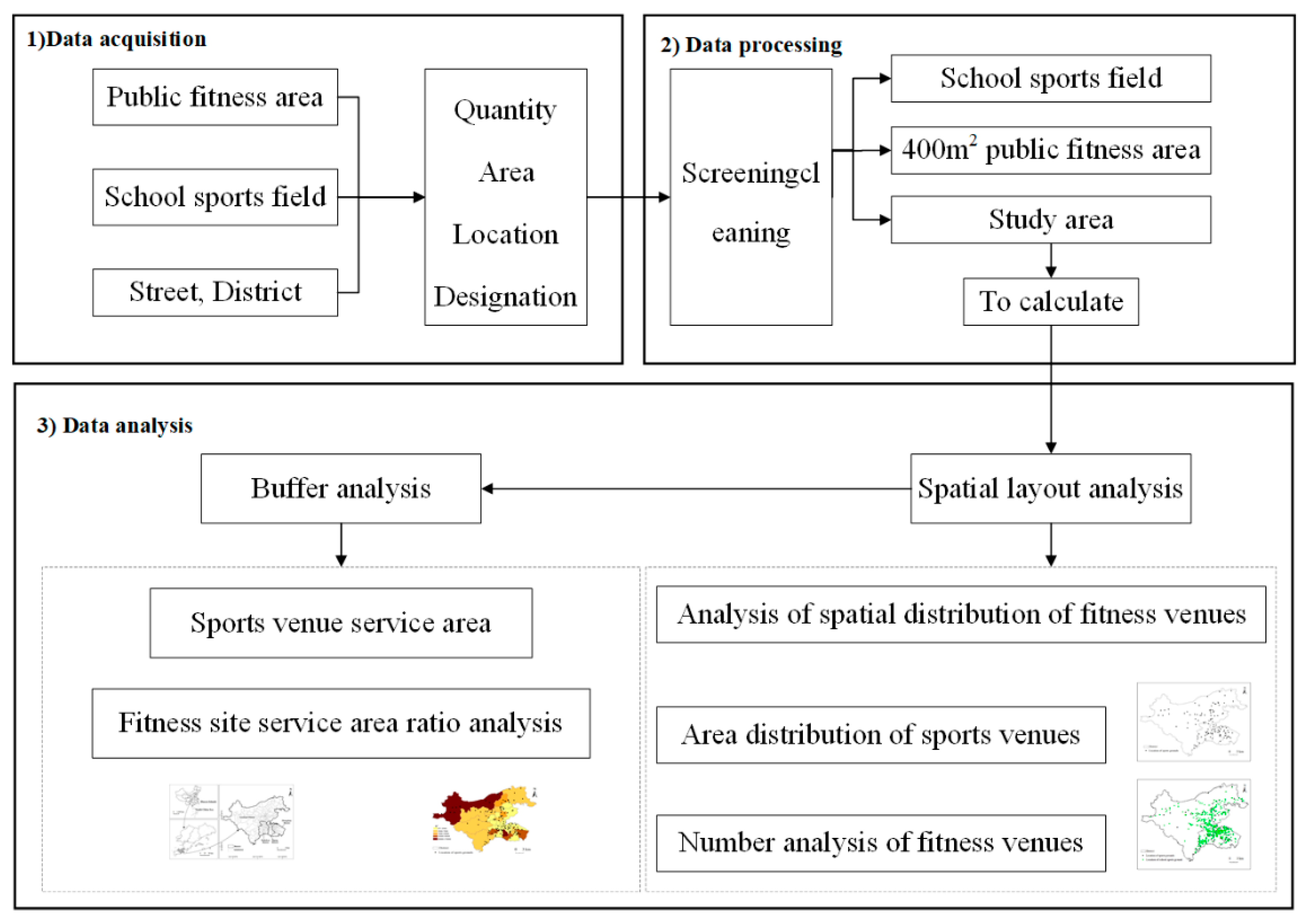
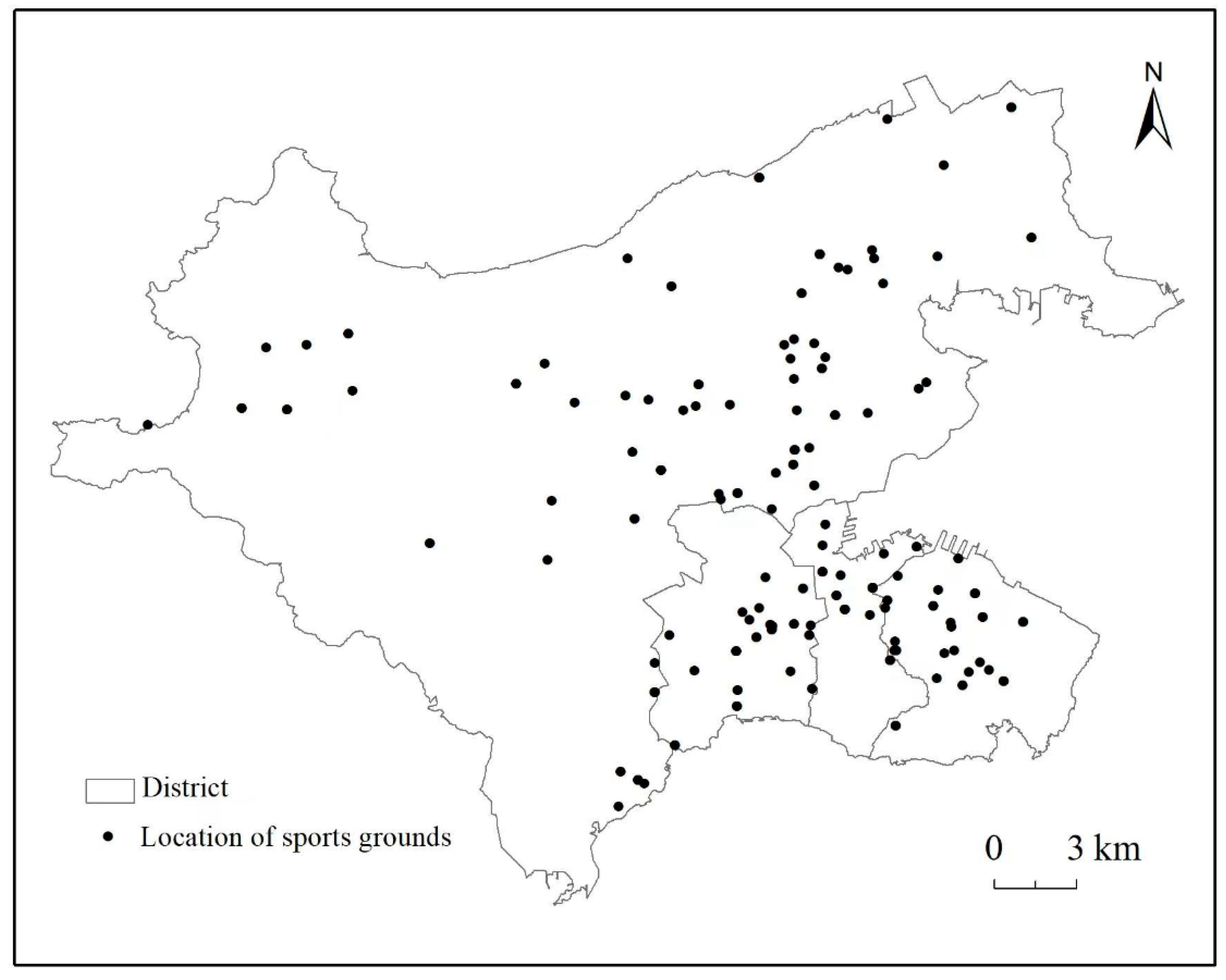
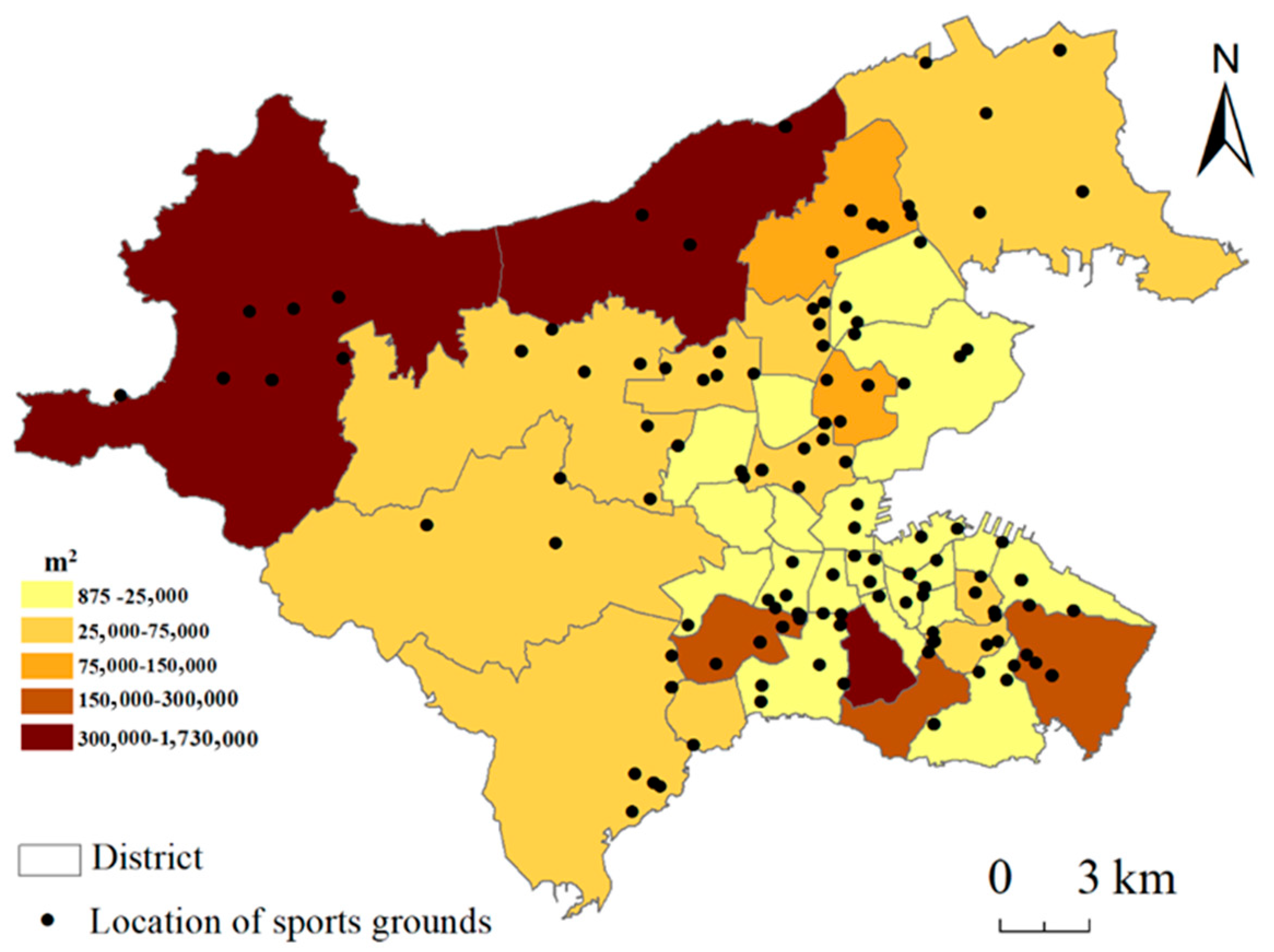
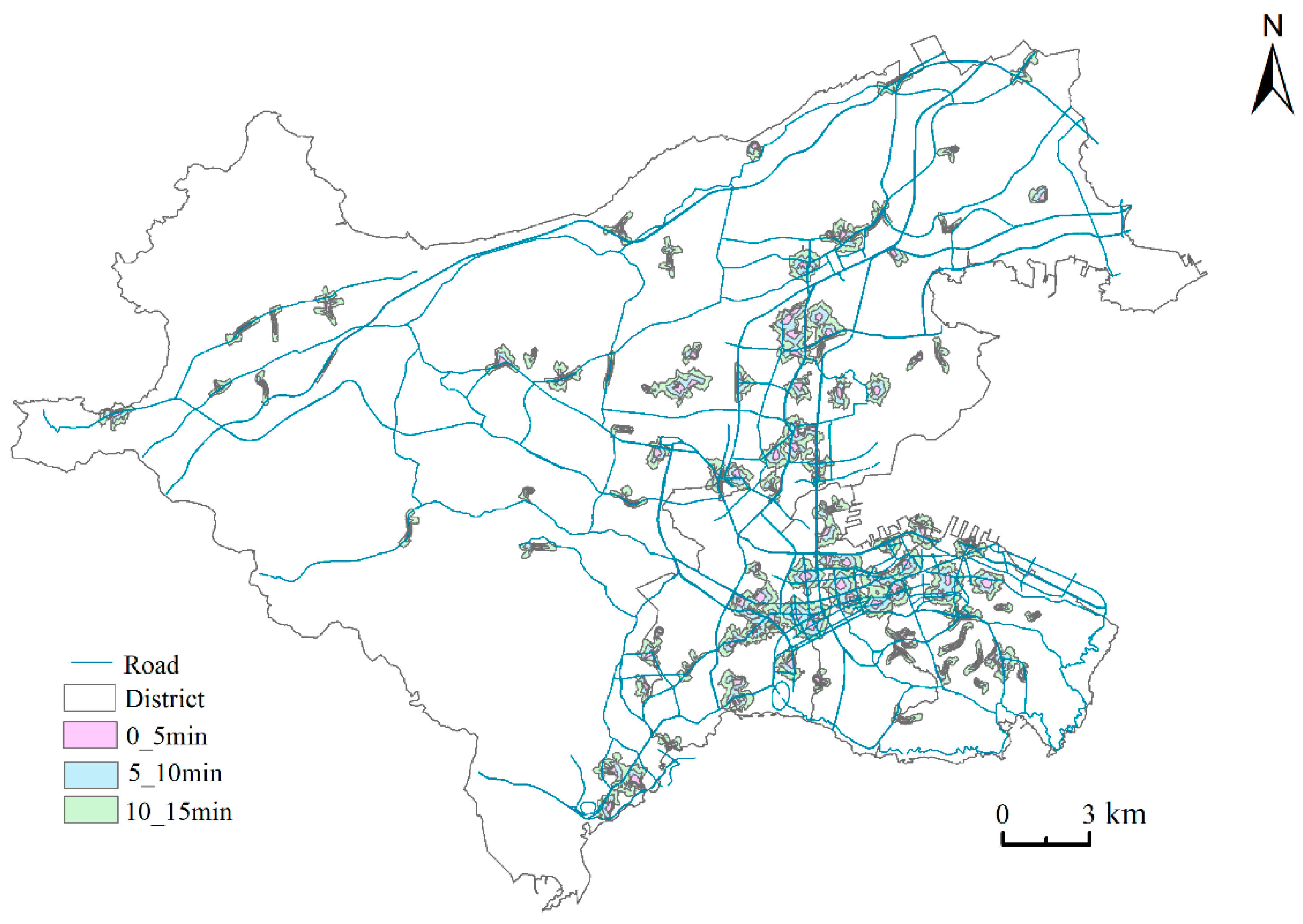
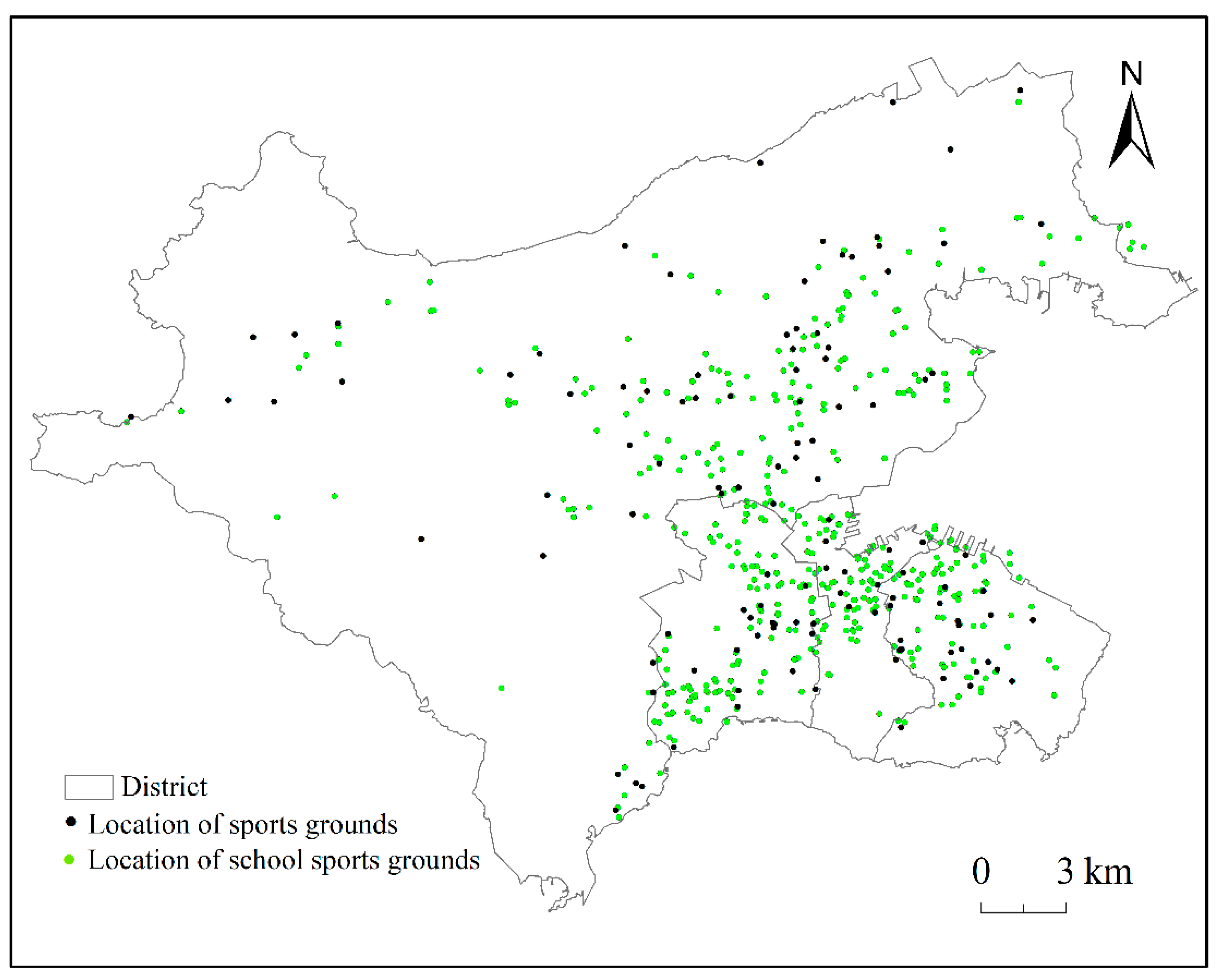
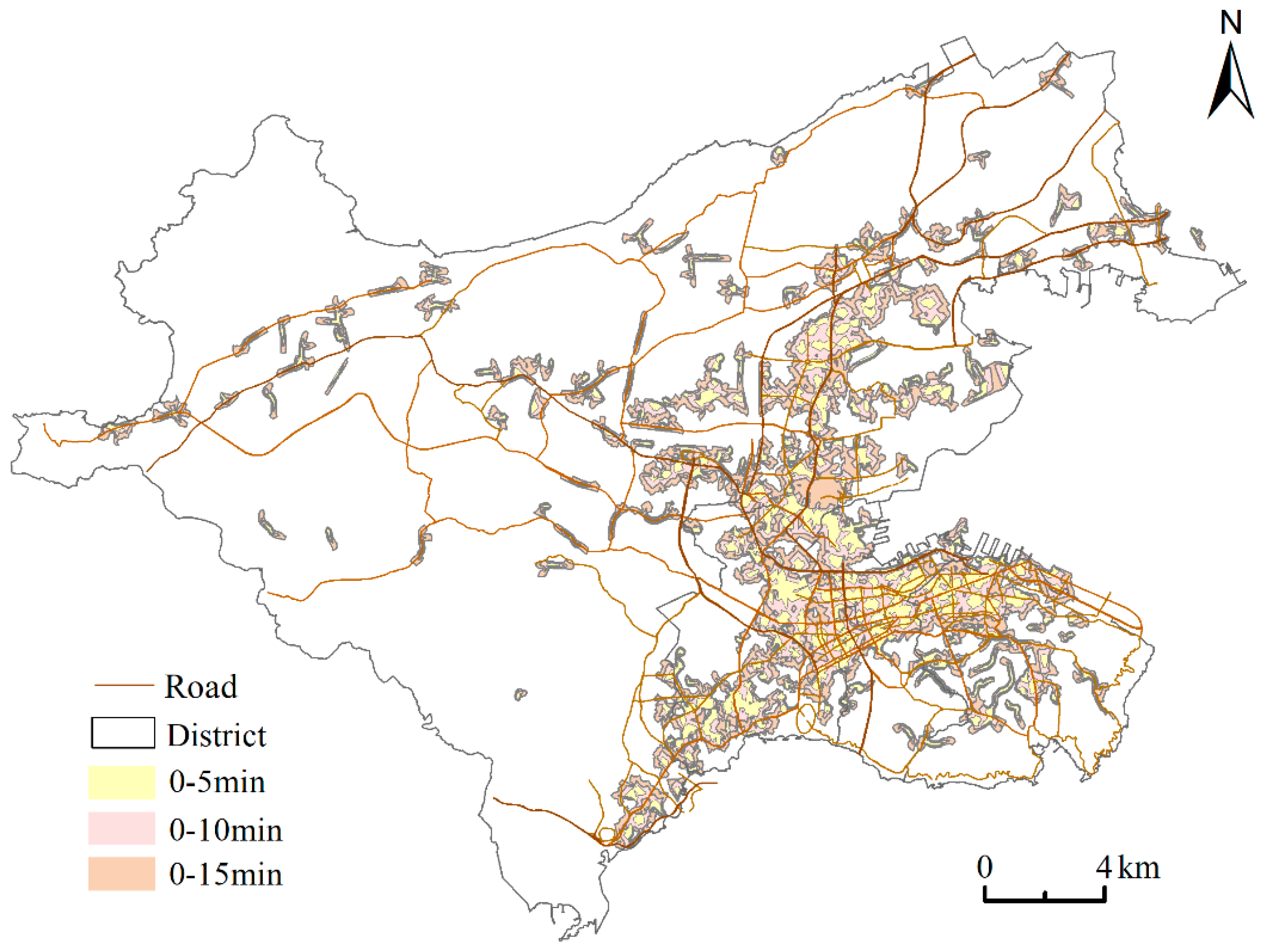
| Data Name | Data Description | Data Sources |
|---|---|---|
| Data of public fitness venues in the main urban area | Site name, area and location | Dalian Sports Bureau, Baidu map |
| Data of school sports venues in main urban areas | Site name, area and location | Dalian Sports Bureau, Baidu map |
| Street map data of main urban district of Dalian | Scope of main urban area street boundary | Resource and Environmental Sciences and Data Center, Baidu map |
| District | Ganjingzi | Shahekou | Xigang | Zhongshan |
|---|---|---|---|---|
| Quantity | 143 | 60 | 36 | 33 |
| Sports area (km2) | 1.43 | 0.97 | 0.78 | 0.27 |
| Number of streets | 14 | 8 | 7 | 9 |
| Area (103 m2) | 0.875–25 | 25–75 | 75–150 | 150–300 | 300–1730 |
|---|---|---|---|---|---|
| Quantity | 20 | 10 | 2 | 3 | 3 |
| The percentage | 52.63 | 26.32 | 5.26 | 7.89 | 7.89 |
| The City Name | Urban Area/(km2) | Site Area/(km2) | The Service Area/(km2) | Service Area Ratio/(%) | ||||
|---|---|---|---|---|---|---|---|---|
| 0–5 | 0–10 | 0–15 | 0–5 | 0–10 | 0–15 | |||
| Zhongshan | 45.44 | 0.27 | 0.77 | 3.33 | 7.74 | 1.70 | 7.37 | 17.13 |
| Shahekou | 43.05 | 0.10 | 0.89 | 3.69 | 8.17 | 2.07 | 8.59 | 19.02 |
| Xigang | 26.45 | 0.78 | 0.56 | 2.59 | 6.27 | 2.18 | 10.09 | 24.42 |
| Ganjingzi | 508.42 | 1.43 | 2.09 | 9.09 | 24.42 | 0.41 | 1.79 | 4.82 |
| Public Fitness Venues | School Premises | Main Fitness Area | Fitness Space Growth (%) | |
|---|---|---|---|---|
| Zhongshan | 33 | 80 | 113 | 242 |
| Shahekou | 60 | 268 | 328 | 447 |
| Xigang | 36 | 147 | 183 | 408 |
| Ganjingzi | 143 | 350 | 493 | 245 |
| The total number | 272 | 845 | 1117 | 311 |
| The average number of | 68 | 211.25 | 279.25 | 311 |
| The City Name | Urban Area/(km2) | Site Area/(km2) | The Service Area/(km2) | Service Area Ratio/(km2) | ||||
|---|---|---|---|---|---|---|---|---|
| 0–5 | 0–10 | 0–15 | 0–5 | 0–10 | 0–15 | |||
| Zhongshan | 45.44 | 0.48 | 3.52 | 9.75 | 16.04 | 7.83 | 21.69 | 35.68 |
| Shahekou | 43.05 | 0.82 | 5.52 | 15.04 | 23.5 | 13.07 | 35.61 | 55.65 |
| Xigang | 26.45 | 1.22 | 4.22 | 9.05 | 12.22 | 16.73 | 35.87 | 48.43 |
| Ganjingzi | 508.42 | 2.38 | 7.99 | 27.84 | 60.27 | 1.58 | 5.5 | 11.91 |
Publisher’s Note: MDPI stays neutral with regard to jurisdictional claims in published maps and institutional affiliations. |
© 2022 by the authors. Licensee MDPI, Basel, Switzerland. This article is an open access article distributed under the terms and conditions of the Creative Commons Attribution (CC BY) license (https://creativecommons.org/licenses/by/4.0/).
Share and Cite
Jiang, Y.; Wang, C.; Zhao, H.; Sun, D.; Shi, Z.; Xia, J. Spatial Distribution Characteristics of Public Fitness Venues in the Main Urban Area of Dalian from the Perspective of Urban Accessibility. Sustainability 2022, 14, 12728. https://doi.org/10.3390/su141912728
Jiang Y, Wang C, Zhao H, Sun D, Shi Z, Xia J. Spatial Distribution Characteristics of Public Fitness Venues in the Main Urban Area of Dalian from the Perspective of Urban Accessibility. Sustainability. 2022; 14(19):12728. https://doi.org/10.3390/su141912728
Chicago/Turabian StyleJiang, Yong, Chunwei Wang, Hongbo Zhao, Dongqi Sun, Zhipeng Shi, and Jianhong (Cecilia) Xia. 2022. "Spatial Distribution Characteristics of Public Fitness Venues in the Main Urban Area of Dalian from the Perspective of Urban Accessibility" Sustainability 14, no. 19: 12728. https://doi.org/10.3390/su141912728
APA StyleJiang, Y., Wang, C., Zhao, H., Sun, D., Shi, Z., & Xia, J. (2022). Spatial Distribution Characteristics of Public Fitness Venues in the Main Urban Area of Dalian from the Perspective of Urban Accessibility. Sustainability, 14(19), 12728. https://doi.org/10.3390/su141912728







